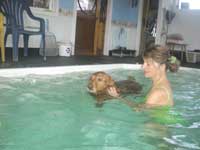Going to the Dogs Fitter Critters Blazes Trails in the Science of Canine Rehabilitation
Jody Chiquoine tells the story of a yellow lab, no older than 6 months, who had a hip condition so grave that the dog couldn’t walk more than a few steps without having to sit. His owner couldn’t afford surgery and was worried he’d have to put him down.
He heard about Fitter Critters, though, Chiquoine’s canine-rehabilitation business in Lee that uses a current pool to help dogs recover from surgery, accidents, and other injuries.
“He didn’t have a lot of money, so he paid for four sessions,” she said. “After one lap around the pool, it was like he was crippled. But as I tell people, sometimes it gets worse before it gets better.”
Fast-forward two years later, and that dog — who kept swimming at Fitter Critters well beyond the first four sessions — is now living with his relieved owner in Florida, where they hike together between 45 and 90 minutes a day. “He never did need surgery,” Chiquoine said. “We’ve had many like that. They’re really remarkable.”
Equally remarkable is the way Chiquoine — a registered nurse for more than 30 years with expertise in rehabilitation, geriatrics, and cancer care — conceived of a business backed by virtually no medical research, and turned it into one of the Berkshires’ most unlikely success stories.
In fact, when she opened the center in 2000, it was the first canine-rehabilitation facility in Massachusetts, and one of only a handful across the U.S. Her inspiration was her Newfoundland, Zowie, who had suffered a traumatic injury a few years earlier.
“She had a broken forearm. I remember the vet saying, after it was pinned, ‘take her home and give her good, supportive care.’ I said, ‘what supportive care?’ If you’re a rehab client, they tell you what to do. I thought, there should be therapists for dogs.
“If it were a person, I’d know what to do,” she added. “But I didn’t know what to do with a dog. I wanted to do something, but I didn’t know what to do.”
Still, intent on providing some kind of post-surgical therapy, she took her dog swimming and worked out some exercises based on her experience with people, and Zowie recovered with no complications.
She didn’t think about canine rehab much after that — until she began itching for a career change.
“I wanted to step away from the healthcare system and see if there was something else I could do with the second half of my life,” said Chiquoine, who was a family nurse practitioner at the time. “And I started spending more and more time with my dogs. I’ve had dogs all my life, and I’ve always been interested in the health aspects of dogs … I guess I really wanted to do something with dogs.”
After a long hike with her canine, she said a light switched on in her brain. “I came home and told my husband, ‘I want to put an addition on our house, and put in a swimming pool and gym, and do rehab for dogs.’
“It was a completely original idea for me,” she added. “He just said, ‘I think it’s an awesome idea.’”
Almost 15 years later, Fitter Critters — based on Chiquoine’s then-uncommon belief that rehabilitation is as important for dogs as it is for people — is not only a thriving business, but an innovative one, regularly visited by curious vets and therapists.
“As more and more people see the benefit of physical therapy for themselves,” she said, “especially people who have had water therapy, they figure, ‘why wouldn’t you do this for your dog?’”
Not Alone
Before launching Fitter Critters, Chiquione visited a number of human rehabilitation facilities and envisioned through a dog’s eyes what her gym would need. Later, she found a canine rehab class in Concord, N.H. “I thought, ‘oh my God — there’s someone else on the planet who has thought about this!’ So I went to the class.”
Later, she became a certified canine rehabilitation therapist through training programs in Florida and Tennessee, and a member of the American Canine Sports Medicine Assoc. She has completed courses in canine massage, acupressure, a treatment method known as ‘Tellington TTouch,’ and the basic science course for animal physical therapists offered by the Orthopedics Division of the American Physical Therapy Assoc.
The certified therapists who work at Fitter Critters treat conditions of all types, from hip, knee, and other joint issues to surgery recovery and early muscle development. In addition to the indoor therapeutic pool, which uses different levels of current for resistance, she installed a water treadmill three years ago, which is especially effective for dogs that fear being completely immersed. Clients are also given home exercises, like stretching and massage, to continue their dogs’ progress during the week.
“Our claim to fame — why people come here — is that we use water a lot differently than most places,” she said. “We use all the physical properties of water to affect the therapy of dogs. The dogs are not just swimming around the pool. We use the pool like other people use the gym. If we think doing circles will improve a limb, we’ll work on circles. We work on neurologically impaired dogs that can’t stand; we’ll do standing exercises in the pool, because they can do things more easily in the pool than they can on land, which speeds recovery.”
She said transitioning from rehabilitating people to doing the same with dogs felt completely natural. “There was no research at the time to show how this would work; it just made a lot of sense — why would the principles of stretching or water not apply to dogs? There were enough physiological similarities that I knew, at the very least, that it was not going to do any harm.”
That’s why the tools of her trade — including physioballs, ultrasound, even cold laser therapy — are the same ones used in the human world. “We use this equipment like a person would use it for therapy. As I said, the dogs don’t just come and swim; they get therapy in the pool. We’re working on different kinds of things for different kinds of problems for different dogs.”
Mind over Matter
One big difference between canines and people is their neurological makeup, which actually gives dogs an edge in recovery.
“Dogs get better a lot faster; their neurological system is rigged slightly different from ours,” Chiquoine said. “That has been fascinating to me. I love neurology, and it’s been a real eye-opener.”
Much of the reason dogs seem to recover from injury more quickly has to do with their simple mindset.
“They don’t have the mental baggage we have; they don’t have the body-image thing,” she explained, citing, for instance, how quickly dogs who lose the use of their hind legs adapt to walking with a cart. “They don’t think, ‘I’m in a wheelchair.’ All they’re thinking is, ‘hey, I’m going for a walk!’”
So when it comes to therapy, she continued, “they see it as an opportunity — no negative, all positive. That’s why differently abled dogs make such good therapy dogs; when kids in hospitals, or veterans, see what the dog is able to do so happily, it makes them reflect on living in the moment and being grateful for what they have instead of what they’ve lost. I think they’re real teachers; humans can learn a lot.
“Of course,” she laughed, “they also don’t have the same responsibilities — they don’t have to make a mortgage payment. They can put all their energy into rehabilitation and being happy.”
Chiquoine said people in Western Mass. tend to embrace dog-centeric businesses, but she also cites a regional openness, at least in the Berkshires, to complementary therapies.
“When we started, it was a very, very novel concept. Veterinarians would say, ‘why do they need rehab? We’ve done surgery like this for years.’ Well, it’s not like dogs won’t heal, but with therapy, there are fewer complications, less risk of injury,” she continued, noting that, when she began, data was largely anecdotal, but since then, plenty of research has backed up the value of canine rehab. “Today, we have at least as many vets telling people to call us as people who find us by word of mouth.”
About 15{06cf2b9696b159f874511d23dbc893eb1ac83014175ed30550cfff22781411e5} of the dogs who come to swim against the current and do other rehab activities are performance, working, or service dogs. “Service dogs are highly valued in people’s lives,” she said. “The amount of training that goes into them is practically irreplaceable. Keeping those dogs in shape for their lives is really important.”
Meanwhile, the vast majority of patients — no less valuable to their families — are companion dogs grappling with orthopedic problems (knee injuries, cruciate tears, etc.) or conditions like arthritis and hip dysplasia. Chiquoine also offers a Weight Watchers-like program called Commit to Be Fit for overweight dogs, while other patients come simply to have fun and stay fit.
“There’s nothing wrong with them,” she said. “They never particularly had a problem, but especially during the really hot months, they can’t get as much walking in, and some people don’t have access to water, so this helps keep them fit over the summer.”
You’ve Got Mail
Chiquione still gets letters from that yellow lab in Florida — well, his owner, anyway — sharing updates on a life that seemed very much in the balance a couple of years ago. And that’s just one of many happy endings.
“We get dogs no one knows what to do with, and we help them turn their lives around,” she told HCN. “It’s very exciting work and very, very fun. We all love it.”




Comments are closed.